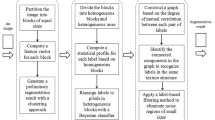Abstract
The dynamic image segmentation algorithm with multiple stepwise evaluation machines was applied to resultant the new boundary from image contents. The concept of data fusion is also discussed in this research for making the good decision of image behavior by a 3D image describer. It achieves the high-understanding objects by merging some non-distinct image domains from the training patterns. Image describer contains expert knowledge to extract appropriate behaviors of the identified image patterns through the efficient dynamic image segmentation algorithm. The novel dynamic image segmentation algorithm is directly applied to explore recognitions of remote sensing images, where it can quickly choice the proper partition number of interesting image patterns area and determine their associated central positions. Due to the specific image intensity appropriately represent in the form of 3D description, an approximation object was dynamically generated with the image partition phase and merging stage to find appropriate 3D image describer. This 3D image describer explicitly presents its feature in diverse maps. Finally, the classification problems of three remote sensing images in computer simulations compared with both k-means and Fuzzy c-means (FCMs) methods. The measurement of misclassification error (ME) is selected to present the great results in various remote sensing images segmentation by the designed algorithm.












Similar content being viewed by others
References
Ashraf S, Brabyn L, Brendan JH (2012) Image data fusion for the remote sensing of freshwater environments. Appl Geogr 32(2):619–628
Ashraf S, Brabyn L, Hicks BJ (2012) Image data fusion for the remote sensing of freshwater environments. Appl Geogr 32(2):619–628
Benz UC, Hofmann P, Willhauck G, Lingenfelder I, Heynen M (2004) Multiresolution, object-oriented fuzzy analysis of remote sensing data for GIS-ready information. ISPRS J Photogramm Remote Sens 58(3):239–258
Bezdek JC (1981) Pattern recognition with fuzzy objective function algorithms. Kluwer Academic Publishers, Norwell
Burnett C, Blaschke T (2003) A multi-scale segmentation/object relationship modelling methodology for landscape analysis. Ecol Model 168(3):233–249
Chatzis SP, Varvarigou TA (2008) A fuzzy clustering approach toward hidden markov random field models for enhanced spatially constrained image segmentation. IEEE Trans Fuzzy Syst 16(5):1351–1361
Chen C-C (2003) Design of fuzzy systems based on partitioning input spaces, Ph.D. Thesis, University of Tamkang, Taiwan
Feng H-M, Chen C-Y (2014) Intelligent dynamic acquisition learning fuzzy system design. J Mar Sci Technol 22(4):430–439
Feng H-M, Liao K-L (2014) Hybrid evolutionary fuzzy learning scheme in the applications of traveling salesman problems. Inf Sci 270:204–225
Gao X, Li J, Tao D, Li X (2007) Fuzziness measurement of fuzzy sets and its application in cluster validity analysis. Int J Fuzzy Syst 9(4):188–197
Kim M, Holt JB, Madden M (2011) Comparison of global- and local-scale pansharpening for rapid assessment of humanitarian emergencies. Photogramm Eng Remote Sens 77(1):51–63
Liu H, Zhao F, Jiao L (2012) Fuzzy spectral clustering with robust spatial information for image segmentation. Appl Soft Comput 12(11):3636–3647
Lu X, Wu H, Yuan Y, Yan P, Li X (2013) Manifold regularized sparse NMF for hyperspectral unmixing. IEEE Trans Geosci Remote Sens 51(5):2815–2826
Melendez-Pastor I, Navarro-Pedreño J, Gómez I, Koch M (2010) Detecting drought induced environmental changes in a Mediterranean wetland by remote sensing. Appl Geogr 30(2):254–262
Neubert M, Herold H, Meinel G (2008) Assessing image segmentation quality -concepts, methods and application. In: Object-based image analysis. Springer, Berlin, pp 769–784
Plaza A, Benediktsson JA, Boardman JW, Brazile J, Bruzaaone L, Camps-Valls G, Chanussot J, Fauvel M, Gamba P, Gualtier A (2009) Recent advances in techniques for hyperspectral image processing. Remote Sens Environ 113:110–122
Smith GM, Morton RD (2010) Real worl objects in GEOBIA through the exploitation of existing digital cartography and image segmenation. Photogramm Eng Remote Sens 76(2):163–171
Swathi N, Ravi Kumar K (2012) Image segmentation based on fuzzy GLSC histogram with dynamic similarity discrimination factor. Int J Sci Technol Res 1(8):143–151
Tansey K, Chambers I, Anstee A, Denniss A, Lamb A (2009) Object-oriented classification of very high resolution airborne imagery for the extraction of hedgerows and field margin cover in agricultural areas. Appl Geogr 29(2):145–157
Tao W, Jin H, Zhang Y, Liu M, Wang D (2008) Image thresholding using graph cuts. IEEE Trans Syst Man Cybern Part A Syst Humans 38(5):1181–1195
Tong H, Maxwell T, Zhang Y, Dey V (2012) A supervised and fuzzy-based approach to determine optimal multi-resolution image segmentation parameters. Photogramm Eng Remote Sens 78(10):1029–1043
Wang L, Pan C (2014) Robust level set image segmentation via a local correntropy-based K-means clustering. Pattern Recogn 47(5):1917–1925
Yang B, Kim M, Madden M (2012) Assessing optimal image fusion methods for very high spatial resolution satellite images to support coastal monitoring. GIsci Remote Sens 49(5):687–710
Yao H, Duan Q, Li D, Wang J (2013) An improved K-means clustering algorithm for fish image segmentation. Math Comput Model 58(3):790–798
Yuan Y, Fu M, Lu X (2015) Low-rank representation for 3D hyperspectral images analysis from map perspective. Signal Process 112:27–33
Zelnik-Manor L, Perona P (2004) Self-tuning spectral clustering. In Advances in neural information processing systems (NIPS), 1601–1608
Zhao F (2013) Fuzzy clustering algorithms with self-tuning non-local spatial information for image segmentation. Neurocomputing 106:115–125
Acknowledgments
This work is partly supported by National Science Council of the Republic of China under Contract 100-2221-E-507-002.
Author information
Authors and Affiliations
Corresponding author
Rights and permissions
About this article
Cite this article
Chen, CY., Feng, HM., Chen, HC. et al. Dynamic image segmentation algorithm in 3D descriptions of remote sensing images. Multimed Tools Appl 75, 9723–9743 (2016). https://doi.org/10.1007/s11042-015-2795-y
Received:
Revised:
Accepted:
Published:
Issue Date:
DOI: https://doi.org/10.1007/s11042-015-2795-y




